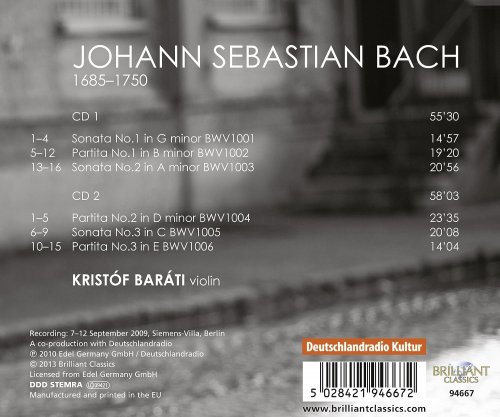
Kristóf Baráti - J.S. Bach: Sonatas & Partitas for Solo Violin (2010)
BAND/ARTIST: Kristóf Baráti
- Title: J.S. Bach: Sonatas & Partitas for Solo Violin
- Year Of Release: 2010
- Label: Brilliant Classics
- Genre: Classical
- Quality: flac lossless (tracks)
- Total Time: 01:53:32
- Total Size: 582 mb
- WebSite: Album Preview
Tracklist
01. Sonata No. 1 in G Minor, BWV 1001: I. Adagio
02. Sonata No. 1 in G Minor, BWV 1001: II. Fuga: Allegro
03. Sonata No. 1 in G Minor, BWV 1001: III. Siciliana
04. Sonata No. 1 in G Minor, BWV 1001: IV. Presto
05. Partita No. 1 in B Minor, BWV 1002: I. Allemanda
06. Partita No. 1 in B Minor, BWV 1002: II. Double
07. Partita No. 1 in B Minor, BWV 1002: III. Corrente
08. Partita No. 1 in B Minor, BWV 1002: IV. Double: Presto
09. Partita No. 1 in B Minor, BWV 1002: V. Sarabande
10. Partita No. 1 in B Minor, BWV 1002: VI. Double
11. Partita No. 1 in B Minor, BWV 1002: VII. Tempo di borea
12. Partita No. 1 in B Minor, BWV 1002: VIII. Double
13. Sonata No. 2 in A Minor, BWV 1003: I. Grave
14. Sonata No. 2 in A Minor, BWV 1003: II. Fuga
15. Sonata No. 2 in A Minor, BWV 1003: III. Andante
16. Sonata No. 2 in A Minor, BWV 1003: IV. Allegro
17. Partita No. 2 in D Minor, BWV 1004: I. Allemanda
18. Partita No. 2 in D Minor, BWV 1004: II. Corrente
19. Partita No. 2 in D Minor, BWV 1004: III. Sarabanda
20. Partita No. 2 in D Minor, BWV 1004: IV. Giga
21. Partita No. 2 in D Minor, BWV 1004: V. Ciaccona
22. Sonata No. 3 in C Major, BWV 1005: I. Adagio
23. Sonata No. 3 in C Major, BWV 1005: II. Fuga
24. Sonata No. 3 in C Major, BWV 1005: III. Largo
25. Sonata No. 3 in C Major, BWV 1005: IV. Allegro assai
26. Partita No. 3 in E Major, BWV 1006: I. Preludio
27. Partita No. 3 in E Major, BWV 1006: II. Loure
28. Partita No. 3 in E Major, BWV 1006: III. Gavotte en Rondeau
29. Partita No. 3 in E Major, BWV 1006: IV. Menuet I, II
30. Partita No. 3 in E Major, BWV 1006: V. Bourée
31. Partita No. 3 in E Major, BWV 1006: VI. Gigue

Bach may well be one of the most widely acknowledged master composers of all time, but that only serves to make each performer’s interpretation of his work all the more challenging and distinctive: each musician must both do justice to the composer’s intention, making a decision as to the best way of conveying that within the music which is not fixed, and at the same time leave their own mark on the performance. This is especially true for these Sonatas and Partitas given the variety of styles in which such Baroque masterworks have been performed, ranging from the freely romantic to the strictly precise, and the technical challenge posed by these complex pieces for a single instrument.
The works in this collection are something of an enigma, not only because of the uncertainty surrounding the circumstances and date of their composition, but, more crucially, because of the way in which they stretch the capacity for polyphony of a single violin beyond its physical limit. It is as though Bach had written for a full ensemble of instruments – but on a single staff. Modern musicians have even speculated as to the possible existence of a special bow with which an exact performance of the music might have been achieved in Bach’s day. The music is no less rich for all of this, however: on the contrary, the harmonic complexity of these pieces is at once captivating and beautiful; the implied but absent notes are thrillingly suggestive; and the multiplicity of voices leaves the listener marvelling at Bach’s compositional vision and the performer’s ability.
This accomplished musical feat is performed by Kristóf Baráti, a Hungarian violinist who has worked with an astonishing number of world-famous orchestras and conductors. Baráti plays a 1703 Stradivarius violin, and one can sense this echo of the era of the pieces as much as one can his intense emotional involvement with the music.
01. Sonata No. 1 in G Minor, BWV 1001: I. Adagio
02. Sonata No. 1 in G Minor, BWV 1001: II. Fuga: Allegro
03. Sonata No. 1 in G Minor, BWV 1001: III. Siciliana
04. Sonata No. 1 in G Minor, BWV 1001: IV. Presto
05. Partita No. 1 in B Minor, BWV 1002: I. Allemanda
06. Partita No. 1 in B Minor, BWV 1002: II. Double
07. Partita No. 1 in B Minor, BWV 1002: III. Corrente
08. Partita No. 1 in B Minor, BWV 1002: IV. Double: Presto
09. Partita No. 1 in B Minor, BWV 1002: V. Sarabande
10. Partita No. 1 in B Minor, BWV 1002: VI. Double
11. Partita No. 1 in B Minor, BWV 1002: VII. Tempo di borea
12. Partita No. 1 in B Minor, BWV 1002: VIII. Double
13. Sonata No. 2 in A Minor, BWV 1003: I. Grave
14. Sonata No. 2 in A Minor, BWV 1003: II. Fuga
15. Sonata No. 2 in A Minor, BWV 1003: III. Andante
16. Sonata No. 2 in A Minor, BWV 1003: IV. Allegro
17. Partita No. 2 in D Minor, BWV 1004: I. Allemanda
18. Partita No. 2 in D Minor, BWV 1004: II. Corrente
19. Partita No. 2 in D Minor, BWV 1004: III. Sarabanda
20. Partita No. 2 in D Minor, BWV 1004: IV. Giga
21. Partita No. 2 in D Minor, BWV 1004: V. Ciaccona
22. Sonata No. 3 in C Major, BWV 1005: I. Adagio
23. Sonata No. 3 in C Major, BWV 1005: II. Fuga
24. Sonata No. 3 in C Major, BWV 1005: III. Largo
25. Sonata No. 3 in C Major, BWV 1005: IV. Allegro assai
26. Partita No. 3 in E Major, BWV 1006: I. Preludio
27. Partita No. 3 in E Major, BWV 1006: II. Loure
28. Partita No. 3 in E Major, BWV 1006: III. Gavotte en Rondeau
29. Partita No. 3 in E Major, BWV 1006: IV. Menuet I, II
30. Partita No. 3 in E Major, BWV 1006: V. Bourée
31. Partita No. 3 in E Major, BWV 1006: VI. Gigue

Bach may well be one of the most widely acknowledged master composers of all time, but that only serves to make each performer’s interpretation of his work all the more challenging and distinctive: each musician must both do justice to the composer’s intention, making a decision as to the best way of conveying that within the music which is not fixed, and at the same time leave their own mark on the performance. This is especially true for these Sonatas and Partitas given the variety of styles in which such Baroque masterworks have been performed, ranging from the freely romantic to the strictly precise, and the technical challenge posed by these complex pieces for a single instrument.
The works in this collection are something of an enigma, not only because of the uncertainty surrounding the circumstances and date of their composition, but, more crucially, because of the way in which they stretch the capacity for polyphony of a single violin beyond its physical limit. It is as though Bach had written for a full ensemble of instruments – but on a single staff. Modern musicians have even speculated as to the possible existence of a special bow with which an exact performance of the music might have been achieved in Bach’s day. The music is no less rich for all of this, however: on the contrary, the harmonic complexity of these pieces is at once captivating and beautiful; the implied but absent notes are thrillingly suggestive; and the multiplicity of voices leaves the listener marvelling at Bach’s compositional vision and the performer’s ability.
This accomplished musical feat is performed by Kristóf Baráti, a Hungarian violinist who has worked with an astonishing number of world-famous orchestras and conductors. Baráti plays a 1703 Stradivarius violin, and one can sense this echo of the era of the pieces as much as one can his intense emotional involvement with the music.
As a ISRA.CLOUD's PREMIUM member you will have the following benefits:
- Unlimited high speed downloads
- Download directly without waiting time
- Unlimited parallel downloads
- Support for download accelerators
- No advertising
- Resume broken downloads


